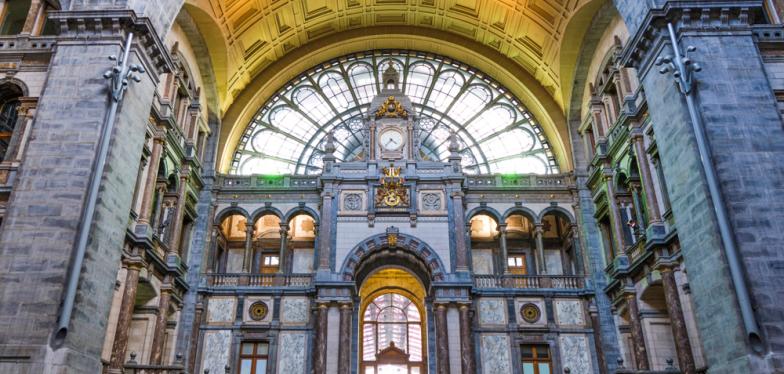Did you know that Antwerp station is one of the most beautiful stations in the world?

Antwerp Central, a station from the past that is looking to the future
Antwerp Central Station, nicknamed the Railway Cathedral, was inaugurated on 11 August 1905. This grand old lady of stone, glass and metal owes its nickname to its large dome, inspired by the Pantheon in Rome. In 2009, the American magazine Newsweek ranked it the fourth most beautiful station in the world.
The original station was called Borgerhout and was built in 1836 as the terminus for the extension of the first railway line of the Belgian state - Brussels- Mechelen-Antwerp. Designed as a temporary station, it was a simple barracks flanked by a few tents and located outside the city walls. The goal was to eventually build a real train station in the city centre. But that would have meant breaking through the defensive walls, which at the time was unthinkable. In 1854, the municipal authorities decided to enlarge the existing building, then called Antwerp East.
Finally released from the 16th century enclosure by a royal decree in 1859, the city rapidly became urbanised around large boulevards. As early as 1880, the construction of a new, decent railway station became a recurring theme for the municipal council. Eleven years later, parliament approved the location for the new station, between the diamond district and the zoo, on what is now Koningin Astridplein. The plans were entrusted to Belgian architect Louis Delacenserie, already famous for his recreation of medieval Bruges and a favourite of King Leopold II. With its serrated domes and skylight turrets, the eclectic main building is reminiscent of Italian palaces. It has eight towers surrounding the heart of the building and seems to have emerged from the Renaissance. Its construction began in 1895 and was completed in 1905, when it received its final name of Antwerp Central. Its enormous waiting room, which can accommodate up to 200,000 passengers per day, is unique in the world. No fewer than twenty varieties of marble were used to decorate it, as well as Doric, Tuscan, Ionic and Corinthian columns. Also made of marble, a sumptuous double staircase captures the attention, particularly as it is surmounted by an enormous clock bearing the city's coat of arms. A glass and iron structure 185 metres long and 44 metres high covers the tracks, protecting passengers from bad weather and removing the smoke and steam emitted by the vehicles of the time.
At the beginning of the 1990s, a series of major changes were necessary due to the saturation of the terminus, the need for a fast link with Brussels and the arrival of the high-speed train. To solve the problem, a north-south junction under the city of Antwerp, in the form of a 3.8 km tunnel, was selected and constructed. This tunnel passes under the central station, which today has four floors and 24 tracks. The TGV has passed 22 meters beneath the ticket office since 25 September 2009. Fast escalators allow passengers to reach its platforms.
While Antwerp Central is famous worldwide due to its beauty, it is also renowned as an example of a successful compromise between the preservation of heritage and adaptation to the requirements of the most modern technologies.
Photo Copyright Shutterstock